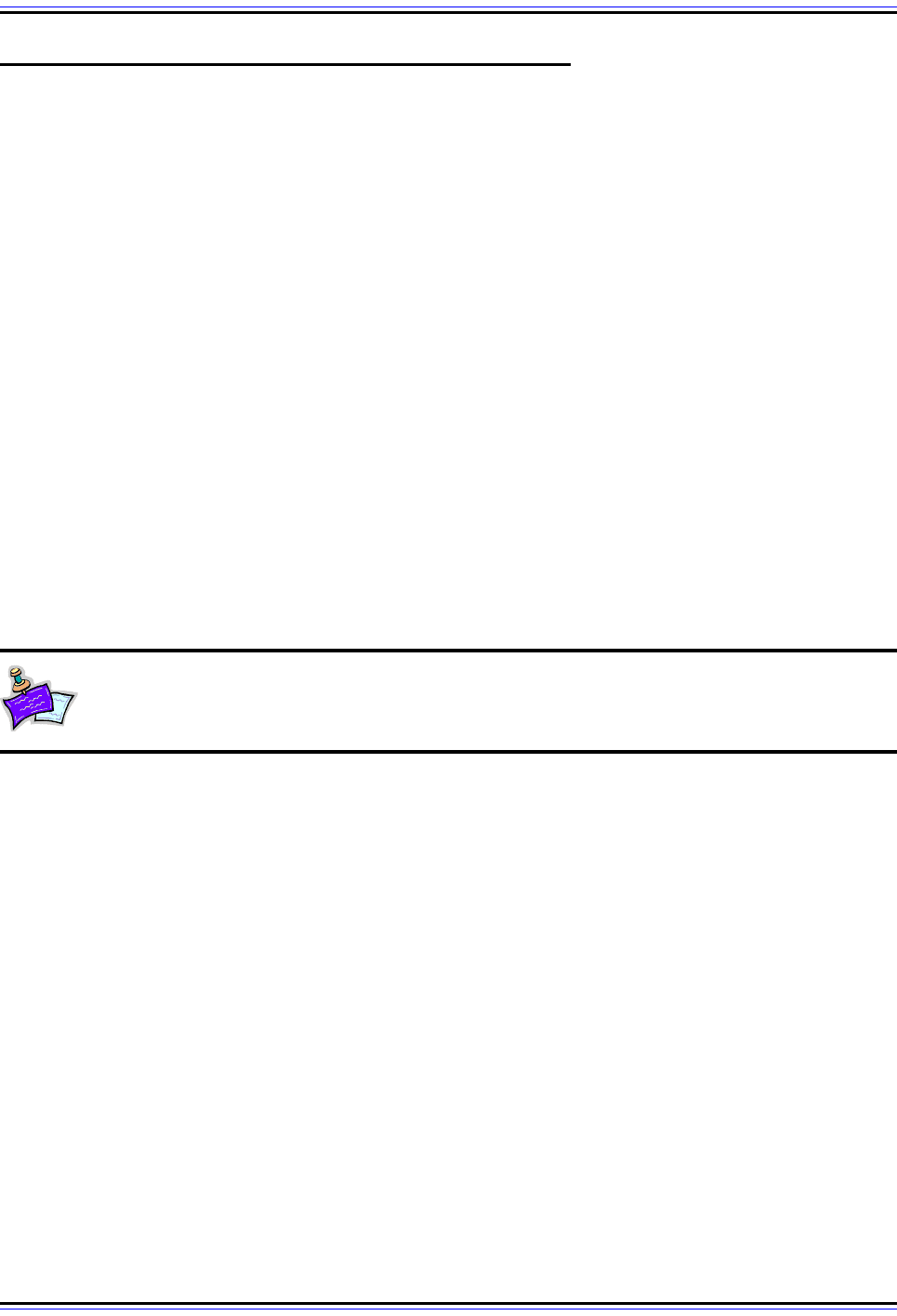Charles M. Kozierok The TCP-IP Guide
Подождите немного. Документ загружается.


The TCP/IP Guide - Version 3.0 (Contents) ` 761 _ © 2001-2005 Charles M. Kozierok. All Rights Reserved.
Furthermore, it is normal for the delay on any link to vary over time; in the case where there
are two routes that are similar in cost, fluctuations in the delay for each route could result in
rapid changes between routes (a phenomenon sometimes called route flapping). Adjust-
ments are needed to the basic overview of the operation of the HELLO protocol above, to
avoid these sorts of problems.
Current Role in TCP/IP
Like other early routing protocols, HELLO includes nothing fancy like authentication and so
on; these features were not really needed in the early days of the Internet, when the inter-
networks were small and easily controlled. As the Internet grew, HELLO was eventually
replaced by newer routing protocols such as RIP. It is now considered a historical protocol
(read: obsolete) and is no longer used.
Key Concept: The HELLO Protocol was used on very early routers on the
precursors of the Internet to exchange routing information. It is a distance-vector
protocol like RIP and GGP but differs in that it uses calculated delay as a metric
instead of hop count. Like GGP, it is now considered a historical protocol and is no longer
part of TCP/IP.
Interior Gateway Routing Protocol (IGRP)
If you have read a substantial portion of this Guide already, you have probably noticed that I
greatly prefer universal, open standards to proprietary standards. (I explain the reasons
why in the Networking Fundamentals section on standards.) I am far from alone in this view,
and in fact, it's no exaggeration to say that much of the success of TCP/IP and the Internet
is tied to the fact that they were both developed using the open RFC process, and still are to
this day.
That said, there are certain situations where a proprietary protocol can be of benefit, and
can even achieve considerable success, if a minimum of two factors are true. First, there
must be either a lack of a suitable open protocol, or a gap in the feature coverage of
existing open protocols that creates an “opportunity” for a proprietary protocol to succeed.
Second, the proprietary protocol must be either initiated or strongly supported by a “big
player” in the industry, to help ensure that other companies will take notice and give the
protocol a chance to become a standard.
This situation arose in the 1980s in the world of routing protocols. At that time, the most
popular interior routing protocol was the Routing Information Protocol (RIP). As described in
the RIP section of this Guide, RIP does a basically good job, but has a number of limitations
and problems that are inherent to the protocol and not easily resolved. In the mid-1980s,
open alternatives like OSPF did not yet exist; even if it had, OSPF is much more complex
than RIP and therefore sometimes not a good alternative.

The TCP/IP Guide - Version 3.0 (Contents) ` 762 _ © 2001-2005 Charles M. Kozierok. All Rights Reserved.
Cisco Systems, definitely one of the “big names” in networking and especially internet-
working and routing, decided to develop a new routing protocol that would be similar to RIP
but would provide greater functionality and solve some of RIP's inherent problems: the
Interior Gateway Routing Protocol (IGRP). IGRP—which conveniently uses both the words
“gateway” and “routing” in its name to convey the equivalence of the two words in internet-
working standards—was designed specifically to be a replacement for RIP. It is similar in
many ways, and keeps RIP's simplicity, one of its key strengths. At the same time, IGRP
overcomes two key limitations of RIP: the use of only hop count as a routing metric, and the
hop count limit of 15.
Overview of Operation
Like RIP, IGRP is a distance-vector routing protocol designed for use with an autonomous
system, and thus uses the same basic mechanism for route determination. Each router
routinely sends out on each local network to which it is attached a message containing a
copy of its routing table. This message contains pairs of reachable networks and costs
(metrics) to reach each network. A router receiving this message knows it can reach all the
networks in the message as long as it can reach the router that sent the message. It
computes the cost to reach those networks by adding to their costs, the cost to reach the
router that sent the message. The routers update their tables accordingly, and send this
information out in their next routine update. Eventually, each router in the autonomous
system has information about the cost to reach each network in it.
Features and Capabilities
An important difference between RIP and IGRP, however, is that where RIP only allows the
cost to reach a network to be expressed in terms of hop count, IGRP provides a much more
sophisticated metric. In IGRP, the overall cost to reach a network is computed based on
several individual metrics, including internetwork delay, bandwidth, reliability and load. The
calculation of cost can be customized by an administrator, who can set relative weightings
to the component metrics to reflect the priorities of that autonomous system. So, if a
particular administrator feels route cost would be best minimized by emphasizing reliability
over bandwidth, he or she can do this. Such a system provides tremendous flexibility over
the rigid hop-count system of RIP. Unlike RIP, IGRP also does not have any inherent limit of
15 hops between networks.
To this basic algorithm, IGRP adds a feature called multipath routing. This allows multiple
paths between routes to be used automatically, with traffic shared between them. The traffic
can either be shared evenly, or apportioned unevenly based on the relative cost metric of
each path. This provides improved performance and again, flexibility.
Since IGRP is a distance-vector protocol like RIP, it shares many of RIP's algorithmic
“issues”. Unsurprisingly, then, IGRP must incorporate many of the same stability features
as RIP, including the use of split horizon, split horizon with poisoned reverse (in certain
circumstances) and the employment of hold-down timers. Like RIP, IGRP also uses timers
to control how often updates are sent, how long routers are “held down”, and how long
routes are held in the routing table before being expired.

The TCP/IP Guide - Version 3.0 (Contents) ` 763 _ © 2001-2005 Charles M. Kozierok. All Rights Reserved.
Cisco originally developed IGRP for IP networks, and since IP is predominant in the
industry, this is where it is most often seen. IGRP is not specific to IP, however, and can be
used with other internetworking protocols if implemented for them. As we will see in the next
topic, Cisco also used IGRP as the basis for an improved routing protocol called EIGRP,
developed several years after the original.
Key Concept: In the 1980s, Cisco Systems created the Interior Gateway Routing
Protocol (IGRP) as an improvement over the industry standard protocol RIP. IGRP is
a distance-vector protocol like RIP and similar to it in many ways, but includes
several enhancements. Amongst the most important of these is an elimination of the 15 hop
limit between routers, and the ability to use metrics other than hop count to determine
optimal routes.
Enhanced Interior Gateway Routing Protocol (EIGRP)
Cisco Systems, a leader in the world of internetworking and routing technology, developed
the Interior Gateway Routing Protocol (IGRP) in the mid-1980s as an alternative protocol to
RIP for use in TCP/IP autonomous systems. IGRP represented a substantial improvement
over RIP, but like any successful company, Cisco was not content to rest on its laurels.
Cisco knew that IGRP had significant room for improvement, so they set to work on creating
a better version of IGMP in the early 1990s. The result was the Enhanced Interior Gateway
Routing Protocol (EIGRP).
Comparing IGRP and EIGRP
Compared to the original protocol, EIGRP is more of an evolution than a revolution. EIGRP
is still a distance-vector protocol, but is more sophisticated than other distance-vector
protocols like IGRP or RIP, and includes certain features that are more often associated
with link-state routing protocols like OSPF than distance-vector algorithms. Also, since
Cisco realized many of the organizations deciding to use EIGRP would be migrating to it
from IGRP, they took special steps to maximize compatibility between the two.
The chief differences between IGRP and EIGRP are not in what they do, but how they do it.
EIGRP changes the way that routes are calculated, in an effort to improve efficiency and
the speed of route convergence (agreement on routes between different routers in the inter-
network). EIGRP is based on a new route calculation algorithm called the Diffusing Update
Algorithm (DUAL), developed at a company called SRI International by Dr. J. J. Garcia-
Luna-Aceves.
EIGRP’s DUAL Route Calculation Algorithm
DUAL differs from a typical distance-vector algorithm primarily in that it maintains more
topology information about the internetwork than that used by protocols like RIP or IGRP. It
uses this information to automatically select least-cost, loop-free routes between networks.
EIGRP uses a metric that combines an assessment of the bandwidth of a link and the total

The TCP/IP Guide - Version 3.0 (Contents) ` 764 _ © 2001-2005 Charles M. Kozierok. All Rights Reserved.
delay to send over the link. (Other metrics are configurable as well, though not recom-
mended.) When a neighboring router sends changed metric information, routes are
recalculated and updates sent as needed. DUAL will query neighboring routers for reach-
ability information if needed (for example, if an existing route fails).
This “as needed” aspect of operation highlights an important way that EIGRP improves
performance over IGRP. EIGRP does not send routine route updates, only partial updates
as required, reducing the amount of traffic generated between routers. Furthermore, these
updates are designed so that only the routers that need the updated information receive
them.
Other Features of EIGRP
In order to build the tables of information it needs to calculate routes, EIGRP requires that
each router make and maintain contact with other routers on their local networks. To facil-
itate this, EIGRP incorporates a neighbor discovery/recovery process. This system involves
the exchange of small Hello messages that let routers discover which other routers on the
local network, and to periodically check their reachability. This is very similar to the use of
the identically-named Hello messages in OSPF, and has a low impact on bandwidth use
because the messages are small and infrequently sent.
Some of the features in IGRP carry through to its successor, such as the use of split horizon
with poisoned reverse for improved stability. In addition to the basic improvements of
efficiency and route convergence that accrue from the algorithm itself, EIGRP includes
some other features. These include support for variable length subnet masks (VLSM) and
support for multiple network-layer protocols. This means that EIGRP could be configured to
function on a network running IP as well as another layer three protocol.
Key Concept: Developed in the 1990s, the Enhanced Interior Gateway Routing
Protocol (EIGRP) is an improved version of Cisco’s IGRP. It is similar to IGRP in
many respects, but uses a more sophisticated route calculation method called the
Diffusing Update Algorithm (DUAL). EIGRP also includes several features that make it
more intelligent in how it computes routes, borrowing concepts from link-state routing
protocols, and using more efficient partial updates rather than sending out entire routing
tables.

The TCP/IP Guide - Version 3.0 (Contents) ` 765 _ © 2001-2005 Charles M. Kozierok. All Rights Reserved.
TCP/IP Exterior Gateway/Routing Protocols (BGP and EGP)
For ease of administration, routers on large internetworks are grouped into autonomous
systems (ASes) that are independently controlled by different organizations and
companies. Interior routing protocols such as RIP and OSPF are used to communicate
routing information between routers within an autonomous system. Obviously, if interior
routing protocols are used within ASes, we need another set of routing protocols to send
that information between ASes. These are called exterior routing protocols.
The entire point of autonomous system architecture is conveyed in the meaning of the first
word in that phrase: autonomous. The details of what happens within an AS are hidden
from other ASes, which allows the administrator of an AS to have the independence to
control how he or she runs it, including the selection of one or more from a variety of
different interior routing protocols. In contrast, to reliably connect ASes together, it is
essential that each one be running the same exterior routing protocol, or the result would be
something akin to the Tower of Babel. The result of this is that in TCP/IP there is generally
only one exterior routing protocol in widespread use at a given time.
In this section I describe two different TCP/IP exterior routing protocols. The first is the
Border Gateway Protocol (BGP), the one used in modern TCP/IP. BGP is very important
since it is used on the current Internet and other larger internetworks, so it is covered in
considerable detail. The second is the Exterior Gateway Protocol (EGP). This is an
obsolete protocol that was used for communication between non-core routers and the
router core in the early Internet, and is described briefly for both completeness and
historical interest.
Background Information: I am assuming in this section that you are already at
least somewhat familiar with interior routing protocols, at least to the extent of
understanding what they do in basic terms. If you have not yet read up on RIP, the
most common interior routing protocol, you may wish to skim that section. At the very least,
make sure you are familiar with the overview of routing protocol architectures.

The TCP/IP Guide - Version 3.0 (Contents) ` 766 _ © 2001-2005 Charles M. Kozierok. All Rights Reserved.
TCP/IP Border Gateway Protocol (BGP/BGP-4)
Modern TCP/IP internetworks are comprised of autonomous systems (ASes) that are run
independently. Each may use an interior routing protocol such as RIP, OSPF, IGRP or
EIGRP to select routes between networks within the AS. To form larger internetworks, and
especially the “mother of all internetworks”, the Internet, these autonomous systems must
be connected together. This requires use of a consistent exterior routing protocol that all
ASes can agree upon, and in today's TCP/IP that protocol is the Border Gateway Protocol
(BGP).
In this section I describe the characteristics, general operation and detailed operation of the
Border Gateway Protocol (BGP). The discussion is divided into two subsections. The first
provides an overview and general look at the operation of BGP, including a discussion of
key concepts such as topology, neighbor relationships, route determination and general
messaging. The second gives a more detailed analysis of the different message types and
how they are used, and describes the format of each message as well.
BGP is another in the rather large group of protocols and technologies that is so complex it
would take dozens of topics to do justice. Therefore, I include here my somewhat standard
disclaimer that you will find in this section only a relatively high-level look at BGP. You will
need to refer to the BGP standards (described in the topic on BGP standards and versions)
if you need more details.
Note: The current version of BGP is version 4, also called BGP-4. This is the only
version widely used today, so unless otherwise indicated, assume BGP-4
wherever you see “BGP”.

The TCP/IP Guide - Version 3.0 (Contents) ` 767 _ © 2001-2005 Charles M. Kozierok. All Rights Reserved.
BGP Fundamentals and General Operation
If you were to ask the average Internet user, or even that typical network administrator, to
make a list of the ten most important TCP/IP protocols, it's probable that BGP wouldn't often
show up. Routing protocols are “worker bees” of the TCP/IP suite and just not very exciting.
The reality, however, is that BGP is a critically important protocol to the operation of larger
internetworks and the Internet itself. It is the “glue” that binds smaller internetworks (auton-
omous systems) together, and it ensures that every organization is able to share routing
information. It is this function that lets us take disparate networks and internetworks and find
efficient routes from any host to any other host, regardless of location.
In this section I begin our look at the very important BGP protocol by covering its basic
concepts and general operation. I start, as usual, with an overview of the protocol and
discussion of its history, standards and versions, including a discussion of its key features
and characteristics. I then cover basic operational concepts, including topology, the notion
of BGP speakers and neighbor relationships. I discuss BGP traffic types and how policies
can be used to control traffic flows on the internetwork. I explain how BGP routers store and
advertise routes, and the function of Routing Information Bases (RIBs). I describe the basic
algorithm used by BGP and how path attributes describe routes. I then provide a summary
of how the BGP route selection process operates. I conclude with a general description of
BGP's operation and its high-level use of various messages.
BGP Overview, History, Standards and Versions
As I describe briefly in the overview of routing protocol concepts, the way that routers were
connected in the early Internet was quite different than it is today. The early Internet had a
set of centralized routers functioning like a “core” autonomous system. These routers used
the Gateway-to-Gateway Protocol for communication between them within the AS, and the
aptly-named Exterior Gateway Protocol (EGP) to talk to routers outside the core.
Motivation and Development of BGP
When the Internet grew and moved to autonomous system (AS) architecture, EGP was still
able to function as the exterior routing protocol for the Internet. However, as the number of
autonomous systems in an internetwork grows, the importance of communication between
them grows as well. EGP was functional but had several weaknesses that became more
problematic as the Internet grew in size. It was necessary to define a new exterior routing
protocol that would provide enhanced capabilities for use on the growing Internet.
In June 1989, the first version of this new routing protocol was formalized, with the
publishing of RFC 1105, A Border Gateway Protocol (BGP)
. This initial version of the BGP
standard defined most of the concepts behind the protocol, as well as key fundamentals
such as messaging, message formats and how devices operate in general terms. It estab-
lished BGP as the Internet's exterior routing protocol of the future.

The TCP/IP Guide - Version 3.0 (Contents) ` 768 _ © 2001-2005 Charles M. Kozierok. All Rights Reserved.
BGP Evolution, Versions and Defining Standards
Due to the importance of a protocol that spans the Internet, work continued on BGP for
many years after the initial standard was published. The developers of BGP had to correct
problems with the initial protocol, refine BGP's operation, improve efficiency, and add
features. It was also necessary to make adjustments to allow BGP to keep pace with other
changes in the TCP/IP protocol suite, such as the invention of classless addressing and
routing.
The result of this ongoing work is that BGP has evolved through several versions and
standards. These are sometimes called BGP-N where N is the version number. Table 134
shows the history of BGP standards, providing the RFC numbers and names and a brief
summary of the changes made in each version.
Table 134: Border Gateway Protocol (BGP) Versions and Defining Standards
RFC
Number
Date Name
BGP
Version
Description
1105
June
1989
A Border Gateway
Protocol (BGP)
BGP-1 Initial definition of the BGP protocol.
1163
June
1990
A Border Gateway
Protocol (BGP)
BGP-2
This version cleaned up several issues with BGP-1,
and refined the meaning and use of several of the
message types. It also added the important concept
of path attributes, which communicate information
about routes.
BGP-1 was designed around the notion of a direc-
tional topology, with certain routers being “up”,
“down” or “horizontal” relative to each other; BGP-2
removed this concept, making BGP better suited to
an arbitrary AS topology.
Note that the RFC title is not a typo; they didn't put
“version 2” in the title.
1267
October
1991
Border Gateway
Protocol 3 (BGP-3)
BGP-3
This version optimized and simplified route infor-
mation exchange, adding an identification capability
to the messages used to establish BGP communi-
cations, and incorporating several other
improvements and corrections.
(They left the “A” off the title of this one for some
reason. ☺)
1654
July
1994
A Border Gateway
Protocol 4 (BGP-4)
BGP-4
Initial standard for BGP-4, revised in RFC 1771.
See just below.
1771
March
1995
A Border Gateway
Protocol 4 (BGP-4)
BGP-4
Current standard for BGP-4. The primary change in
BGP-4 is support for Classless Inter-Domain
Routing (CIDR). The protocol was changed to allow
prefixes to be specified that represent a set of
aggregated networks. Other minor improvements
were also made to the protocol.

The TCP/IP Guide - Version 3.0 (Contents) ` 769 _ © 2001-2005 Charles M. Kozierok. All Rights Reserved.
As you might imagine, changing the version of a protocol like BGP is not an easy under-
taking. Any modification of the protocol would require the coordination of many different
organizations. The larger the Internet grows, the more difficult this would be. As a result,
despite frequent version changes in the early 1990s, BGP-4 remains today the current
version of the standard, and is the one that is widely used. Unless otherwise specified, any
mention of BGP in this Guide refers to BGP-4.
BGP Supplementary Standards
Supplementing RFC 1771 are three other consecutively-numbered RFCs published simul-
taneously with it, which provide supporting information about BGP's functions and use, as
shown in Table 135.
Overview of BGP Functions and Features
If I were to summarize the job of BGP in one phrase, it would be “to exchange network
reachability information between autonomous systems and from this information determine
routes to networks”. In a typical internetwork (and in the Internet) each autonomous system
designates one or more routers that run BGP software. BGP routers in each autonomous
system are linked to those in one or more other autonomous systems. Each BGP stores
information about networks and the routes to them in a set of Routing Information Bases
(RIBs). This route information is exchanged between BGP routers, and propagated
throughout the entire internetwork, allowing each AS to find paths to each other AS, and
thereby enabling routing across the entire internetwork.
Table 135: Additional Defining Standards For BGP-4
RFC
Number
Name Description
1772
Application of the Border
Gateway Protocol in the
Internet
Provides additional conceptual information on the
operation of BGP and how it is applied to and used on the
Internet.
This document is sometimes considered a companion of
RFC 1771 with the pair defining BGP-4.
1773
Experience with the BGP-4
Protocol
Describes the experiences of those testing and using
BGP-4, and provides information that justified its accep-
tance as a standard.
1774 BGP-4 Protocol Analysis
Provides more detailed technical information about the
operation of the BGP-4 protocol.

The TCP/IP Guide - Version 3.0 (Contents) ` 770 _ © 2001-2005 Charles M. Kozierok. All Rights Reserved.
Key Concept: The exterior routing protocol used in modern TCP/IP internetworks is
the Border Gateway Protocol (BGP). Initially developed in the late 1980s as a
successor to EGP, BGP has been revised many times; the current version is 4, so
BGP is also commonly called BGP-4. BGP’s primary function is the exchange of network
reachability information between autonomous systems to allow each AS on an internetwork
to send messages efficiently to every other one.
BGP supports an arbitrary topology of ASes, meaning they can be connected in any
manner. An AS must have a minimum of one router running BGP, but can have more than
one. It is also possible to use BGP to communicate between BGP routers within the same
autonomous system.
BGP uses a fairly complex system for route determination. The protocol goes beyond the
limited notion of considering only the next hop to a network the way distance-vector
algorithms like RIP function. Instead, the BGP router stores more complete information
about the path (sequence of autonomous systems) from itself to a network. Special path
attributes describe the characteristics of paths, and are used in the process of route
selection. Because of its storage of not just next-hop but path information, BGP is
sometimes called a path vector protocol.
BGP chooses routes using a deterministic algorithm that assess path attributes and
chooses an efficient route while avoiding router loops and other problem conditions. The
selection of routes by a BGP router can also be controlled through a set of BGP policies
that specify, for example, whether an AS is willing to carry traffic from other ASes or not.
However, BGP cannot guarantee the most efficient route to any destination, because it
cannot know what happens within each AS and therefore what the cost is to traverse each
AS.
BGP's operation is based on the exchange of messages that perform different functions.
BGP routers use Open messages to contact neighboring routers and establish BGP
sessions. They exchange Update messages to communicate information about reachable
networks, sending only partial information as needed. They also use Keepalive and Notifi-
cation messages to maintain sessions and inform peers of error conditions. The use of
these messages is summarized in the topic on BGP general operation, with details
(including message formats) in the section on detailed operation.
BGP uses TCP as a reliable transport protocol, so it can take advantage of the many
connection setup and maintenance features of that protocol. This also means that BGP
doesn't need to worry about issues such as message sequencing, acknowledgements, or
lost transmissions. Since unauthorized BGP messages could wreak havoc with the
operation of the Internet, BGP includes an authentication scheme for security.
